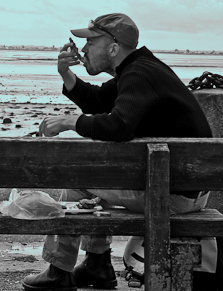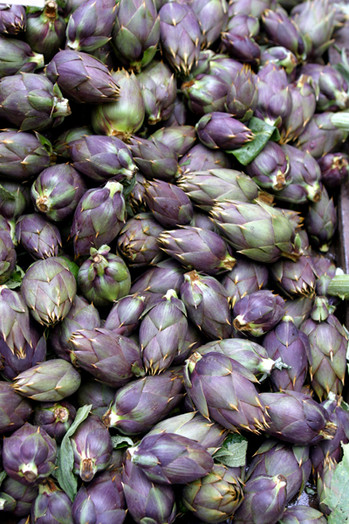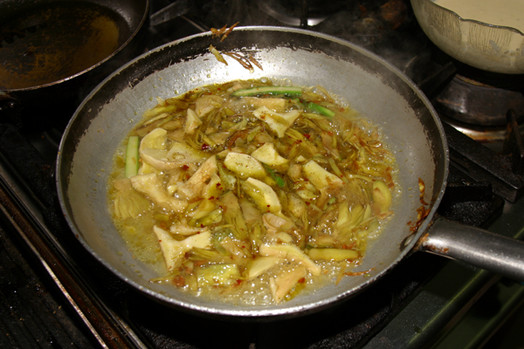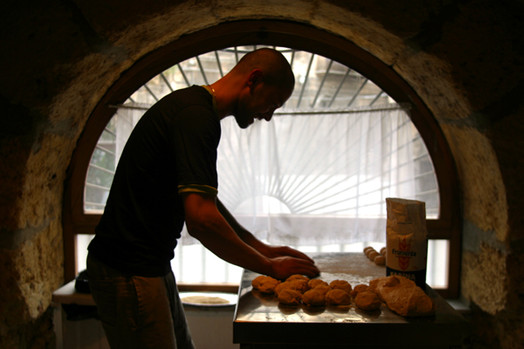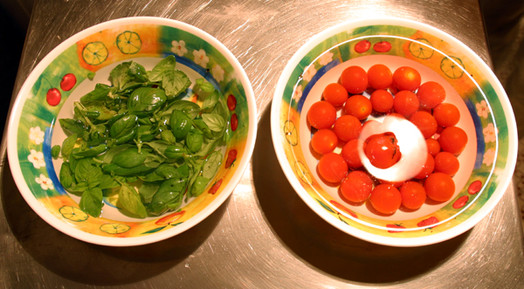Joe Ray
Food & Travel / Words & Photos
Tuesday, April 24, 2007
Winking At The Matriarch
A calm chef is a rare bird, usually signifying that his restaurant is about to fold or that he’s depressed. In Peppino Carollo’s case, however, his calm comes from successfully crossing a bridge from traditional Sicilian cuisine to something that is his own.
“I don’t like making carbonara. Pannacotta? I can’t do it,” he said referring to heavy Italian classics.
Here in Sicily, tradition often comes from harder times like making it through a famine or feeding a town surrounded by an attacking enemy.
Today, matriarchs have it easier but still need to fill the bellies of their ilk at seemingly endless Sunday meals and restaurant food here can be heavy enough that you understand why things like vomitoriums used to be installed around the island.
While Carollo’s cooking is clearly Sicilian, a meal at his Castelbuono restaurant, Nangalarruni, leaves you with that healthy, end-of-a-sushi-meal feeling.
“It makes me happy to create new sensations,” he said. “I like to let the old recipes remind me of the past…I think of grandma when I cook, but I do my own stuff.”
Right now, this means concentrating on artichokes.
For Carollo, the keys are three closely tied concepts: seasonality, simplicity and perfect products. There’s also the pleasantly curious addition of economy.
“In November (when they are hard to get), an artichoke costs one euro (about $1.30). Now, they’re cheap. This is the time to get them,” he said, helping to explain why his highly-respected establishment is also known as a bargain.
He demonstrated this with three plates highlighting artichokes – a carpaccio with cheese and oranges, a batter-dipped classic called carciofi in pastella and in a veggie sauce to accompany fresh tagliatelle. None of these dishes took more than 15 minutes to prepare.
For the tagliatelle, he put a large saucepan over medium-high flame, poured a thick coat of olive oil onto the bottom and added two peeled garlic cloves that he had lightly crushed with his hand. He cut the tops off of a couple of artichokes, pinched off several outer layers of leaves, halved them lengthwise and cored with a pen knife called a Siciliano. He sliced the halves into skinny strips and tossed them in the pan, giving it a flip or two that painted them the rich green of the olive oil. While that cooked, he peeled and halved a couple asparagus tips, added those, then sliced a few handfuls of local mushrooms and tossed them on top.
“They are all ingredients that only need a little cooking time.” he said. “You want to feel their al dente – their crunch.”
He removed the garlic, added a few small ladles of a light vegetable broth, along with some salt, pepper and red pepper flakes and let the whole thing bubble away while he tossed the fresh tagliatelle into boiling water.
“The tagliatelle gets one minute to cook. Just one,” he said, gently brushing me out of the way before he pulled it out and added it to the saucepan with the vegetable sauce.
“It’s very quick cooking, very healthy… buono,” he said plating the pasta and making that ‘lips kissing fingertips’ gesture before adding a few sprigs of wild fennel and a final drizzle of olive oil, over the top, the warmth of the dish releasing the aroma of the final additions.
Looking like he spent a lot of time watching his grandmothers cook as he grew up, there’s also an impressive practicality to the way he cooks. He holds the artichokes by the stem as he dips them into a batter before frying to reduce mess, he smells the olive oil every time he uses it and the closest thing he seems to have to measuring cups are his hands.
Though he’s clearly pushing things in a new direction, his pastella turns out to be almost identical to one I had prepared by a grandmother at a family dinner the day before.
“We don’t do a lot of fried stuff,” he said, but hunched his shoulders as if to say that this was one part of tradition that was best left untouched.
This is Joe Ray reporting from the Motherland.
Sunday, April 15, 2007
Sabrina’s Simplicity and Rules of Rites
If you want to mess with a Sicilian’s head, try playing with their preconceptions about food.
This is a pet theory of mine that I’ve been having fun testing out over the past week.
Last week, for example, I came back from the market with some leafy vegetable I had never seen, along with zucchini and pasta, thinking I’d throw something together for dinner. Giuseppe (see last entry) immediately sent me back to the market to buy the right kind of zucchini (the three-foot long cousin of what I bought) before he’d show me what to do with the leaves.
Similarly, I had just sat down to lunch with Sabrina Gianforte – a Sicilian who both helps run Confezionando, her family’s fancy-food store in Palermo and is in charge of her own gastronomic consultancy – and I had already disappointed her.
“You can’t eat fish without having wine!” she said, rather uninterested with how drinking at lunch wipes me out for the rest of the day. “You’re disappointing me!”
“Here,” she said, reassuming a serious tone, “lunch is a rite.”
Half an hour earlier, she had brought me to Palemo’s Ballaro Market, picked out some fish (a leopard-skinned murena eel, and a large red fish), paid the fishmonger and left him with a small gift from her shop. We brought the fish with us to the restaurant and gave it to the chef.
“You can only do this if you know the chef very, very well,” she says, reeling off a very short list of places she can do it.
The eel came back with spaghetti and broth, which was exquisitely simple – a preparation that is a sort of privilege of this kind of freshness. The flesh was somewhere between ‘regular’ whitefish and monkfish and the skin added a nice silky texture.
Later, the fish arrived whole, with little more done to it than baking it in a hot oven. It was dropped off by the chef and accompanied only by small plates and a fork and knife. It was up to us to serve ourselves.
It’s this simplicity that gets us comparing about Sicilian restaurant fare and home cooking.
“What are the first things you remember about your mother’s cooking?” asked Sabrina.
We both pause for about 10 seconds to think back and smile.
“I remember chops and breadcrumbs,” she said, before reflecting some more.
“Another time, I was playing with friends and went home and my mom made a sandwich with egg, cheese and parsley,” she says, making the gesture of Sicilian sandwich makers when the scoop out the inside of the roll with their fingers to make more room for the filling. “I thought it was magic.”
Sometimes, you wander into restaurants here and wonder if they aren’t just reproducing home cooking on a larger scale, but it’s not necessarily a bad thing.
This is Joe Ray reporting from the Motherland.
Sunday, April 08, 2007
Giuseppe & Giuseppe
Once a week, the bar downstairs from my flat does little tapas-style appetizers. If you show up at about eight, you can make a meal out of it, paying only for what you drink. It’s not high gastronomy, but good, traditional stuff, and makes for a full house.
Giuseppe, who works at the bar and comes from Trapani (Sicily’s western tip), does all of the cooking. I’m sure he’s paid for his time, but it’s his initiative and he certainly does it more for fun than money.
On Thursday, I gave him a hand in the kitchen, doing everything from rolling out and baking little brioches from dough he made the day before to putting together two pasta dishes. He even made tiny versions of arancini – literally “little oranges” that are classic Sicilian street food - cooked rice balls with any combination of ground beef, tomato sauce, peas, eggs, ham and cheese, the whole thing rolled in fine breadcrumbs and quickly fried.
As most Sicilians who cook still tend to be women, it’s a funny thing for a twenty-something guy to do for fun, but for Giuseppe, that’s part of the connection.
“This is the cooking that my mother and grandmother did,” he says, and clearly he was paying attention as he grew up. For one pasta dish, he’s got tomatoes that have been briefly boiled to loosen their skin, yet he makes the whole sauce separately, cooking button mushrooms, basil, zucchini, red onion, a healthy glug of olive oil, salt, pepper and nutmeg. Only when everything else is cooked does he dice the tomatoes directly into the pot.
“If you cook the tomatoes in the sauce, they lose their flavor,” he says.
He gives the whole thing a stir and sticks his nose in the pot and breathes in deep. “Que odore!” he exclaims in our multi-language mix.
Later, he gets ready to fry the arancini he’s prepped the day before. He’s got a pot on the stove with a couple of inches of oil inside clinking away as it heats up and there’s not a thermometer in sight.
“How do you know when it’s hot enough?” I ask.
“I know.”
“Ah.”
And why cook something so typical at a trendy neighborhood bar?
“Because it’s pleasing. It’s good.” he says, clearly at a bit of a loss for why I’d wonder such a thing. “Why do you eat hot dogs in America? Because they’re good.”
Later, he pulls out a jar of tiny, round red peppers he’s brought for a little work-time snack. They’re stuffed with a mix of classic Sicilian ingredients – capers, tuna and parsley – all soaking in olive oil.
I pop one into my mouth and it dissolves, pushing the corners of my mouth upward in a big, quiet grin.
“They cost a fortune,” he says, “about 12 euros (about $15) for a little pot, but they’re a classic, and they’re orgasmic.”
It looks like the classics will last for at least one more generation.
This is Joe Ray reporting from the Motherland.
